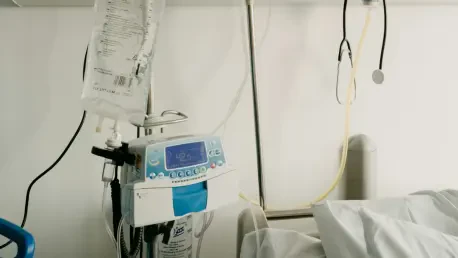In recent years, infusion pump technology has heralded transformative changes in the medical landscape, significantly impacting patient care standards and healthcare delivery methods. Despite their life-saving potential, recent concerns regarding their safety have emerged, casting a spotlight on their robustness and design intricacies. This review delves into infusion pumps’ current state—evaluating their performance metrics, key components, challenges, and evolving trends.
In-Depth Examination of Infusion Pumps
Infusion pumps have revolutionized how medications and fluids are administered, offering precision and consistency in delivery. The advent of these sophisticated devices has redefined traditional medical practices, emphasizing automated drug delivery as a central feature. By streamlining the administration process, they have improved the precision of drug delivery, minimizing human errors and boosting overall healthcare efficiency. The core components of infusion pumps integrate advanced technologies to ensure programmed delivery rates and volumes, unfolding a layer of reliability critical to patient safety.
A pivotal aspect of these pumps is their automation capabilities, which allow for controlled drug doses over extended periods. This functionality mitigates the risk of overdosing, thereby enhancing patient care, especially in critical situations. As the technological landscape continues to advance, infusion pumps incorporate more refined sensors and controllers that enable sophisticated responses to varying patient conditions.
Safety Protocols and Challenges
While the technological evolution of infusion pumps has made notable strides, ensuring patient safety remains paramount. Safety alarms and protocols embedded within these devices are vital, designed to detect irregularities and alert medical professionals promptly. The reliability of such safety mechanisms is under constant scrutiny, with false alarms and technical malfunctions identified as persistent issues. These challenges necessitate ongoing refinement to safeguard against potential treatment interruptions.
The recent recalls of certain models due to operational failures amplify the necessity for comprehensive quality checks. Factors such as network compatibility issues and thermal component damage have highlighted vulnerabilities that require proactive risk management solutions. Continuous evaluation and adherence to stringent regulatory standards are essential to address these complications and maintain trust in their usage.
Innovations and Real-World Implications
Emerging trends and innovations are shaping the future trajectory of infusion pump technology. The integration of wireless connectivity and enhanced data analytics is fostering a new era of smart devices that bolster healthcare monitoring capabilities. These advancements pave the way for adaptive technologies that not only improve patient outcomes but also optimize clinician workflows.
In practical applications, infusion pumps are indispensable across various healthcare settings, from surgical suites to intensive care units. Their versatility allows for broad utilization, offering tailored solutions across a continuum of care needs. The ability to support complex treatment regimens and deliver continuous medication makes them critical in managing chronic conditions and acute care interventions.
Regulatory Hurdles and Future Prospects
Despite their benefits, infusion pumps are not immune to technical and regulatory challenges. Stringent oversight ensures their safety and efficacy, often leading to recalls when devices fall short of expectations. Manufacturers are tasked with continuous innovation to overcome these barriers, aiming to enhance reliability and minimize disruptions in patient care.
Looking onward, the infusion pump industry is poised for substantial advancements. Future innovations are likely to focus on increased automation, interoperability with other medical devices, and enhanced user interfaces for more intuitive operation. As these devices evolve, they hold potential to substantially transform healthcare practices, promoting a shift toward more integrated and efficient patient care solutions.
In summary, while current infusion pump technologies provide impressive capabilities in healthcare delivery, ongoing refinements are necessary to maximize their impact. The challenges faced underscore the importance of diligent regulatory compliance and innovative solutions to ensure these devices continue to enhance patient safety and treatment efficacy across the medical spectrum.









